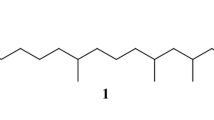Abstract
All stereoisomers of three diepoxyalkenes derived from (3Z,6Z,9Z)-trienes with a C21, C19, or C18 straight chain, lymantriid sex pheromones and their candidates, were synthesized by MCPBA oxidation of optically active epoxyalkadienes. Their chromatographic behaviors were examined with GC and LC equipped with achiral and chiral columns. Detailed inspection of the mass spectra of these epoxides indicated the following diagnostic ions for determining the chemical structures: m/z 128, 167, M-87 and M-85 for (Z)-cis-3,4-cis-6,7-diepoxy-9-enes; m/z 111, M-125 and M-69 for (Z)-cis-6,7-cis-9,10-diepoxy-3-enes; and m/z M-125 and M-139 for (Z)-cis-3,4-cis-9,10-diepoxy-6-enes. Mass chromatographic analysis that monitored these fragment ions revealed the existence of a new pheromonal compound with a C21 chain in an extract from virgin females of a lymantriid species, Perina nuda F. The three diepoxyalkenes were converted into the corresponding DMDS adducts, which showed characteristic ions from fragmentation between the two thiomethyl groups, reflecting the position of an original double bond.
Similar content being viewed by others
REFERENCES
ANDO, T., OHSAWA, H., UENO, T., KISHI, H., OKAMURA, Y., and HASHIMOTO, S. 1993. Hydrocarbons with a homoconjugated polyene system and their monoepoxy derivatives: Sex attractants of geometrid and noctuid moths distributed in Japan. J. Chem. Ecol. 19:787–798.
ANDO, T., KISHI, H., AKASHIO, N., QIN, X.-R., SAITO, N., ABE, H., and HASHIMOTO, S. 1995. Sex attractants of geometrid and noctuid moths: Chemical characterization and field test of monoepoxides of 6,9-dienes and related compounds. J. Chem. Ecol. 21:299–311.
ANDO, T., OHTANI, K., YAMAMOTO, M., MIYAMOTO, T., QIN, X.-R., and WITJAKSONO. 1997. Sex pheromone of Japanese giant looper, Ascotis selenaria cretacea: Identification and field tests. J. Chem. Ecol. 23:2413–2423.
ARN, H., TÓTH, M., and PRIESNER, E. 1992. List of sex pheromones of Lepidoptera and related attractants. OILB-SROP/IOBC-WPRS, Secrétariat Général, F-84143 Montfavet, France, 179 pp.
ARN, H., TÓTH, M., and PRIESNER, E. 1997. List of sex pheromones of Lepidoptera and related attractants, supplement 1992–1996. Technol. Trans. Mating Disrup. 20:257–293.
BUSER, H.-R., ARN, H., GUERIN, P., and RAUSCHER, S. 1983. Determination of double bond position in mono-unsaturated acetates by mass spectrometry of dimethyl disulfide adducts. Anal. Chem. 55:818–822.
GRIES, R., HOLDEN, D., GRIES, G., WIMALARATNE, P. D. C., SLESSOR, K. N., and SAUNDERS, C. 1997. 3Z-cis-6,7-cis-9,10-Di-epoxy-heneicosene: Novel class of Lepidopteran pheromone. Naturwissenschaften 84:219–221.
MILLAR, J. G. 2000. Polyene hydrocarbons and epoxides: A second major class of lepidopteran sex attractant pheromones. Annu. Rev. Entomol. 45:575–604.
MORI, K. 1994. Synthetic and stereochemical aspects of pheromone chemistry. Pure Appl. Chem. 66:1991–1998.
PU, G.-Q., YAMAMOTO, M., TAKEUCHI, Y., YAMAZAWA, H., and ANDO,T. 1999. Resolution of epoxydienes by reversed-phase chiral HPLC and its application to stereochemistry assignment of mulberry looper sex pheromone. J. Chem. Ecol. 25:1151–1162.
QIN, X.-R., ANDO, T., YAMAMOTO, M., YAMASHITA, M., KUSANO, K., and ABE, H. 1997. Resolution of pheromonal epoxydienes by chiral HPLC, stereochemistry of the separated enantiomers and their field evaluation. J. Chem. Ecol. 23:1403–1417.
YAMAMOTO, M., YAMAZAWA, H., NAKAJIMA, N., and ANDO, T. 1999a. A convenient preparation of optically active diepoxyhenicosene (Leucomalure), lymantriid sex pheromone, by chiral HPLC. Eur. J. Org. Chem. 1999:1503–1506.
YAMAMOTO, M., TAKEUCHI, Y., OHMASA,Y., YAMAZAWA, H., and ANDO, T. 1999b. Chiral HPLC resolution of monoepoxides derived from 6,9-dienes and its application to stereochemistry assignment of fruit-piercing noctuid pheromone. Biomed. Chromatogr. 13:410–417.
YAMAMOTO, M., KISO, M., YAMAZAWA, H., TAKEUCHI, J., and ANDO, T. 2000. Identification of the chiral sex pheromone secreted by the giant geometrid moth, Biston robustum Butler. J. Chem. Ecol. 26:2579–2590.
Author information
Authors and Affiliations
Rights and permissions
About this article
Cite this article
Yamazawa, H., Nakajima, N., Wakamura, S. et al. Synthesis and Characterization of Diepoxyalkenes Derived from (3Z,6Z,9Z)-Trienes: Lymantriid Sex Pheromones and Their Candidates. J Chem Ecol 27, 2153–2167 (2001). https://doi.org/10.1023/A:1012255201380
Issue Date:
DOI: https://doi.org/10.1023/A:1012255201380



